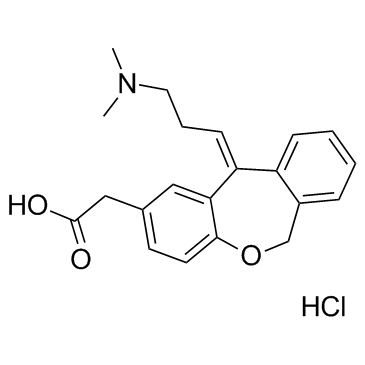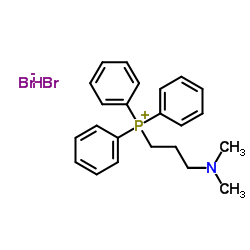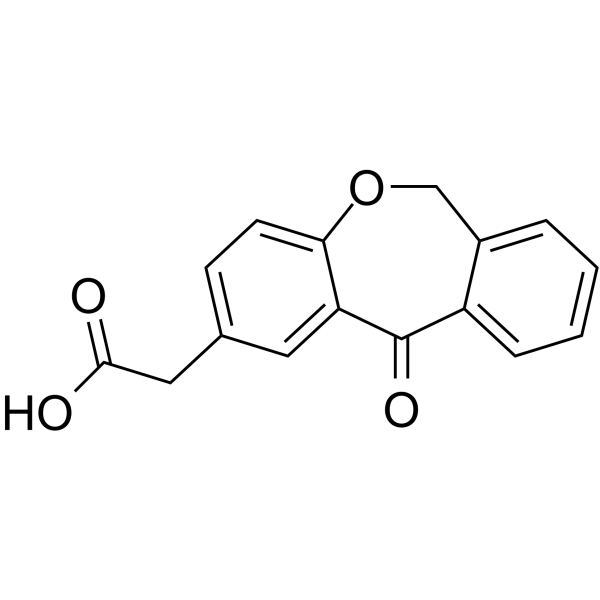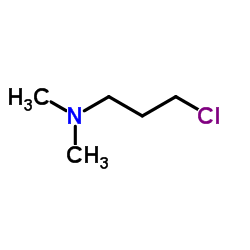Olopatadine Hydrochloride

Olopatadine Hydrochloride structure
|
Common Name | Olopatadine Hydrochloride | ||
|---|---|---|---|---|
| CAS Number | 140462-76-6 | Molecular Weight | 373.873 | |
| Density | 1.221 g/cm3 | Boiling Point | 523ºC at 760mmHg | |
| Molecular Formula | C21H24ClNO3 | Melting Point | 242-245ºC | |
| MSDS | Chinese USA | Flash Point | 270.1ºC | |
| Symbol |


GHS06, GHS09 |
Signal Word | Danger | |
Use of Olopatadine HydrochlorideOlopatadine HCl is a histamine blocker used to treat allergic conjunctivitis.Target: Histamine ReceptorOlopatadine is one of the second-generation histamine H1 receptor antagonists that are treated for allergic disorders. Olopatadine significantly inhibited the ear swelling and the increased production of IL-4, IL-1beta, IL-6, GM-CSF and NGF in the lesioned ear [1]. Olopatadine was highly and rapidly absorbed in healthy human volunteers. The urinary excretion of olopatadine accounted for not less than 58% and the contribution of metabolism was considerably low in the clearance of olopatadine in humans. Olopatadine is one of the few renal clearance drugs in antiallergic drugs. Olopatadine was shown to be useful for the treatment of allergic rhinitis and chronic urticaria in double-blind clinical trials [2]. AL-4943A inhibits histamine release in a concentration-dependent fashion (IC50 = 559 microM) from human conjunctival mast cell preparations in vitro. Passive anaphylaxis in guinea pig conjunctiva was attenuated by AL-4943A applied 30 min prior to intravenous or topical ocular antigen challenge (ED50 values 0.0067% and 0.0170%, w/v, respectively) [3]. |
| Name | Olopatadine Hydrochloride |
|---|---|
| Synonym | More Synonyms |
| Description | Olopatadine HCl is a histamine blocker used to treat allergic conjunctivitis.Target: Histamine ReceptorOlopatadine is one of the second-generation histamine H1 receptor antagonists that are treated for allergic disorders. Olopatadine significantly inhibited the ear swelling and the increased production of IL-4, IL-1beta, IL-6, GM-CSF and NGF in the lesioned ear [1]. Olopatadine was highly and rapidly absorbed in healthy human volunteers. The urinary excretion of olopatadine accounted for not less than 58% and the contribution of metabolism was considerably low in the clearance of olopatadine in humans. Olopatadine is one of the few renal clearance drugs in antiallergic drugs. Olopatadine was shown to be useful for the treatment of allergic rhinitis and chronic urticaria in double-blind clinical trials [2]. AL-4943A inhibits histamine release in a concentration-dependent fashion (IC50 = 559 microM) from human conjunctival mast cell preparations in vitro. Passive anaphylaxis in guinea pig conjunctiva was attenuated by AL-4943A applied 30 min prior to intravenous or topical ocular antigen challenge (ED50 values 0.0067% and 0.0170%, w/v, respectively) [3]. |
|---|---|
| Related Catalog | |
| References |
| Density | 1.221 g/cm3 |
|---|---|
| Boiling Point | 523ºC at 760mmHg |
| Melting Point | 242-245ºC |
| Molecular Formula | C21H24ClNO3 |
| Molecular Weight | 373.873 |
| Flash Point | 270.1ºC |
| Exact Mass | 373.144470 |
| PSA | 49.77000 |
| LogP | 4.39150 |
| Vapour Pressure | 9.65E-13mmHg at 25°C |
| InChIKey | HVRLZEKDTUEKQH-NOILCQHBSA-N |
| SMILES | CN(C)CCC=C1c2ccccc2COc2ccc(CC(=O)O)cc21.Cl |
| Storage condition | Refrigerator |
| Symbol |


GHS06, GHS09 |
|---|---|
| Signal Word | Danger |
| Hazard Statements | H301-H400 |
| Precautionary Statements | P273-P301 + P310 |
| Hazard Codes | T,N |
| Risk Phrases | 25-50 |
| Safety Phrases | 45-61 |
| RIDADR | UN 2811 6.1 / PGIII |
| HS Code | 2932999099 |
| Precursor 9 | |
|---|---|
| DownStream 0 | |
| HS Code | 2932999099 |
|---|---|
| Summary | 2932999099. other heterocyclic compounds with oxygen hetero-atom(s) only. VAT:17.0%. Tax rebate rate:13.0%. . MFN tariff:6.5%. General tariff:20.0% |
|
Topical cyclosporine a 1% for the treatment of chronic ocular surface inflammation.
Eye Contact Lens 40(5) , 283-8, (2014) To evaluate the use of topical cyclosporine A (CsA) 1% emulsion in the treatment of chronic ocular surface inflammation (OSI).We conducted a retrospective chart review of patients with various forms o... |
|
|
Histamine suppresses regulatory T cells mediated by TGF-β in murine chronic allergic contact dermatitis.
Exp. Dermatol. 24(4) , 280-4, (2015) Regulatory T cells (Tregs) suppress effector T cells and ameliorate contact hypersensitivity (CH); however, the role of Tregs in chronic allergic contact dermatitis (CACD) has not been assessed. Repea... |
|
|
Chromatographic analysis of olopatadine in hydrophilic interaction liquid chromatography.
J. Chromatogr. Sci. 53 , 680-6, (2015) In this paper, chromatographic analysis of active substance olopatadine hydrochloride, which is used in eye drops as antihistaminic agent, and its impurity E isomer by hydrophilic interaction liquid c... |
| AL 4943A |
| MFCD00875716 |
| Olopatadine hydrochloride |
| Dibenz[b,e]oxepin-2-acetic acid, 11-[3-(dimethylamino)propylidene]-6,11-dihydro-, (11Z)-, hydrochloride (1:1) |
| {(11Z)-11-[3-(Dimethylamino)propylidene]-6,11-dihydrodibenzo[b,e]oxepin-2-yl}acetic acid hydrochloride |
| {(11Z)-11-[3-(Dimethylamino)propyliden]-6,11-dihydrodibenzo[b,e]oxepin-2-yl}essigsäurehydrochlorid |
| {(11Z)-11-[3-(Dimethylamino)propylidene]-6,11-dihydrodibenzo[b,e]oxepin-2-yl}acetic acid hydrochloride (1:1) |
| dibenz[b,e]oxepin-2-acetic acid, 11-[3-(dimethylamino)propylidene]-6,11-dihydro-, (11Z)-, hydrochloride |
| acide {(11Z)-11-[3-(diméthylamino)propylidène]-6,11-dihydrodibenzo[b,e]oxépin-2-yl}acétique chlorhydrate |
| Olopatadine (hydrochloride) |
![(11-oxo-6,11-dihydro-dibenzo[b,e]oxepin-2-yl)-acetic acid benzyl ester Structure](https://image.chemsrc.com/caspic/215/60548-16-5.png) CAS#:60548-16-5
CAS#:60548-16-5 CAS#:27710-82-3
CAS#:27710-82-3 CAS#:113806-05-6
CAS#:113806-05-6 CAS#:113805-63-3
CAS#:113805-63-3 CAS#:19070-16-7
CAS#:19070-16-7 CAS#:55453-87-7
CAS#:55453-87-7![(Z)-11-[3-(dimethylamino)propylidene]-6,11-dihydrodibenz[b,e]oxepin-2-acetic acid methyl ester Structure](https://image.chemsrc.com/caspic/356/113806-01-2.png) CAS#:113806-01-2
CAS#:113806-01-2![(Z)-11-(3-dimethylaminopropylidene)-6,11-dihydrodibenz[b,e] oxepin-2-acetic acid ethyl ester Structure](https://image.chemsrc.com/caspic/280/113806-03-4.png) CAS#:113806-03-4
CAS#:113806-03-4 CAS#:109-54-6
CAS#:109-54-6